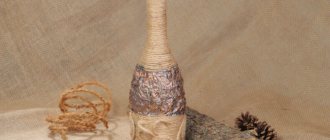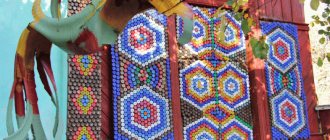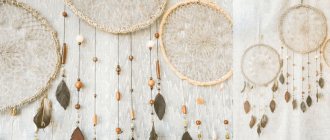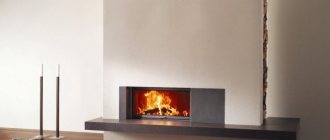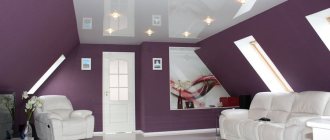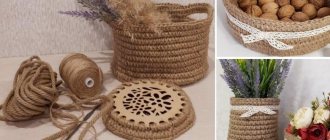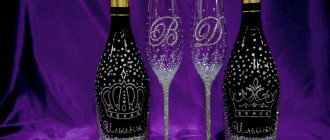How to decorate a bottle
You can make your own bottle decor using various materials. The following is often used as a basis:
- - leg-split;
- - ropes;
- - tapes;
- - paper;
- - skin;
- - eggshells;
- - salty dough;
- - pasta;
- - cereals.
You can also use beads, decorative stones, sea salt, paint for decoration...
Advantages of plastic products
A beautiful vessel with flowers will lift your spirits on a stormy day. Often people can boast of a home collection of flower vessels. They are alternated depending on the mood, the occasion for celebration, and simply matching them with new wallpaper. If you already have a few glass items in your bins, it's time to replenish your stock with plastic items.
Pros of homemade vases:
Price. Due to the low cost of the material, the finished product is quite inexpensive. A family with an average budget can decorate their home with this decor.- Sustainability. Neither playful children nor playful pets can break a plastic flowerpot.
- Availability. Making a vase from a plastic bottle with your own hands is very simple. It will take a little time and effort.
- Relevance. If you get tired of this copy, feel free to take it to the trash cans and sit down to make a new one.
- Development. You will be able to practice handicrafts, design skills and involve your household in this activity.
Coffee bottle made of twine
For this bottle decor you will need:
- - Glass bottle;
- - leg-split;
- - glue gun and sticks for it;
- - coffee beans.
Progress:
- 1. It is necessary to wash the bottle well and degrease it, using alcohol.
- 2. Using a glue gun, wrap the bottle from the neck to the bottom with twine.
- 3. Repeat another layer with twine, there should be no show-through, each roll of twine should be pressed tightly against each other.
- 4. Glue the coffee beans in a fairly orderly manner, with the convex side.
This bottle will fit very well into almost any interior, both in the kitchen and in the living room.
How to make a cute vase from a glass bottle
Today I will tell you how you can make something cute out of scrap things. Thanks to the comments of the masters in my previous master class, I remembered the technique that I enjoyed doing 15 years ago. A minimum of money is required for implementation, and the pleasure from the result can be great. The vase is made for dried flowers (not for water). The process of “draping” a bottle takes no more than an hour, but it should dry for at least 12 hours, preferably a day.
You will need: a glass bottle, PVA glue, gouache, a piece of light fabric, thread or lace, a brush and patience. Here I will tell you a slightly more time-consuming method, but below I will tell you how you can combine two steps into one, saving an extra hour.
It is better to take a piece of some cotton fabric, plain, light (this way the paint will be visible better). I didn't have anything like this on hand, so I took a piece from an old T-shirt.
I cut out a piece of fabric about 5 cm larger than the height of the bottle, and 10 cm larger than the circumference of its bottom.
I tie the fabric around the neck of the bottle with a cord so that it does not move and interfere with work.
I start working from the bottom of the bottle and work my way up. First I apply a little glue to the bottle where the fabric cut will be.
I apply the fabric and also coat it with glue.
I overlap the second cut.
I coat the nearby area of the fabric with glue, not sparing it.
I create waves with my fingers. I work with my bare hands - PVA washes off my hands well. Personally, gloves just get in the way for me. At the very beginning I work with a lying bottle.
Then I put it vertically and continue to apply glue and create waves with my fingers.
Having reached the top, I carefully remove the lace, holding the top of the fabric so that it does not fall. I generously coat the fabric and neck with glue and drape the top of the bottle, leaving the fabric a centimeter above the neck so that it does not peek out.
It turns out this is the form. One last look around the entire circumference, correcting what I don’t like and leaving it to dry. It’s better to leave it overnight, or even better for a day - then the PVA will set as strongly as possible.
When you can grasp the vase with your hands without deforming the fabric, I begin to apply paint with a dry brush. But, since there are many folds in the vase and it is difficult to penetrate them, see the tip below. I like the process of applying paint, so I did it that way.
The end result was a vase like this:
Tips:
- You can combine two steps: pour PVA glue into some unnecessary container and add gouache of the desired color there (at least half of a standard jar will be needed). In the future, coat the fabric with this particular mixture (this way you won’t have to cover the vase with the first layer of paint after drying). Keep in mind that the color will fade a bit as it dries, so don't skimp on the paint. You can also add acrylic paint.
- You can imagine that you are a traumatologist, immediately soak a piece of fabric in the resulting mixture of PVA glue and paint and then apply it to the bottle (similar to applying plaster). The glue takes a long time to dry, so you have time to give the vase the desired shape.
- The shapes you give to the fabric are limited only by your imagination.
- If the resulting color seems faded to you, you can paint the top of the vase with the same gouache, you will get a beautiful effect. You can use paint of a different color. You can even make it multi-colored - it all depends on your imagination.
Anticipating comments:
- I used almost the entire 120 g tube of PVA for this vase (what was on hand). You can buy a large jar of PVA at a hardware store for little money and use it - it will be cheaper.
- I did not use gouache, but acrylic paint - this way the color is more saturated.
Bottle decor with paper or napkins
Bottles decorated with paper or napkins look very interesting. Very often, this is the method used to make New Year’s bottle decorations with your own hands. This technique of decorating bottles is not too complicated and does not require special skills or a significant amount of time.
The main thing is to choose good quality napkins for use, preferably they consist of 3 balls. Decorating a bottle with napkins or paper is called decoupage.
How to cut the neck at home
The vase itself from a glass bottle can be made with your own hands in different ways. Before you start decorating, you will have to carry out the necessary operation - removing the neck of the bottle. Of course, you can leave it, then very few flowers will fit in such a vessel. Choose what is best for you.
If you decide to cut off the neck, it’s easy to do even without using a cutting tool. You will need the following:
- dense woolen thread no more than half a meter long;
- solvent (acetone, gasoline, alcohol, kerosene);
- lighter or matches;
- container with water;
- gloves and glasses (if you care about your safety);
- sandpaper (skin), a block for sharpening blades is suitable.
The sequence of work will be as follows:
- Take the bottle in your hands and mark a line where you want the “cut”.
- Dip the thread into the solvent.
- Wind it around the bottle in the designated place so that the thread is in three layers (the exact size can be determined in advance by trying on).
- Quickly light the thread. Hold the bottle horizontally.
- When the thread burns, immediately place the object in a container of cold water.
- Due to a sharp temperature change, the glass will burst exactly in the place where the thread was and the heating occurred.
- Sand the sharp edges with sandpaper or a block. The second is best done in water.
So, from a bottle you can make a blank for a vase. Even from identical containers it is easy to get different shapes. It is enough to change the position of the thread vertically (higher or lower). You can even place it diagonally, then the cut will be appropriate.
Decoupage bottles
To decorate a bottle using decoupage technique you will need:
- - bottle;
- — three-layer napkins with the desired pattern;
- - white acrylic paint;
- - acrylic transparent varnish;
- - scissors.
Progress:
- 1. It is necessary to wash and degrease the bottle well.
- 2. Paint the entire bottle with white acrylic paint and let dry.
- 3. Divide the napkins into layers.
- 4. Cut out the desired piece of the napkin or you can use it entirely.
- 5. Carefully apply the napkin to the bottle and cover with acrylic varnish.
- 6. Let the bottle sit and dry.
When covering a napkin with acrylic varnish, you should act carefully but quickly so that bubbles do not form on the surface. You can also use various ribbons, lace, sparkles for additional decoration...
Vases from a plastic bottle
Waterproof material allows you to design containers suitable for their intended use - for flowers. Vases can serve not only to put a bouquet in them. Products such as candy bowls or containers for small items do not even require complete waterproofing, so they can be designed as your imagination dictates. The use of threads and weaving, openwork, and additional decorative elements in decoration allows you to create beautiful crafts from plastic bottles and similar waste material.
Fruit bowl
A beautiful vase for sweets or fruit can be easily made from 2 Coca-Cola or Fanta bottles (volume 2 l). A simple master class will help you do everything without difficulty:
- Preparing parts. Cut off the part with the neck from 1 container approximately at the level of the transition of the expanding fragment into the straight sides. Separate a straight strip of sidewalls from the bottom and cut it vertically to obtain a wide plastic strip. Separate the bottom part from the second bottle, leaving the sides of maximum length on the fragment with the neck.
- Assembling the stand. Align the small part with the neck along the cut line so that the neck is vertical. Trace a circle around its edge on a piece of thick cardboard for the base. Roll the strip from the side into a tight tube and insert it into the neck of the fragment. To weight the structure, you can use pebbles, plasticine or a little gypsum mortar poured into the cavity of the stand. Use pieces of masking tape to attach the cardboard circle to the base, covering it from the bottom.
- Making a bowl. Cut the sides of the larger fragment into strips 3 cm wide, until the beginning of the beveled parts of the neck. Moving the edges of the strips to equal distances (3-4 cm), glue them together with strips of tape, forming a wide conical bowl. After this, cover the plastic base with pieces of newsprint on both sides until the plastic is completely hidden. Dry. For gluing, you can use PVA glue.
- Connecting parts. The part of the bottle rolled into a tube, inserted into the lower part, serves to connect the bowl and stand. It needs to be inserted into the neck of the bottle, which is covered with papier-mâché. When everything is assembled into a single structure, cover the vase with pieces of paper, tearing off all the plastic surfaces. Determine whether the vase will be stable. If it falls off easily, glue a larger circle of cardboard or an old DVD to the base.
You can decorate the vase using the method suggested below or use your own imagination:
- stick paper napkins onto the papier-mâché surface, crumpling them and creating a textured surface from them;
- make the edge of the bowl curly and cover the edge with napkins;
- dry;
- moistening the napkins with glue, twist them into thin ropes, from which a convex ornament is formed;
- after drying, cover the entire surface with dark acrylic paint;
- Apply bronze or other paint with a metallic effect to the convex parts of the finish with a semi-dry brush;
- add decor as desired.
Vase for small items and flowers
An easy-to-make vase is available even for a child who decides to please his mother or teacher on March 8th. It is made by cutting off the bottom or neck (the difficulty of execution depends on this). When separating part of the container, you can cut 2-4 strips from the side parts without separating them from the selected fragment. After this, the ends of the strips are connected above the center of the cut container, creating a basket.
If a neck is chosen for the bowl, the bottom is cut off along the edge of the relief, forming a flower from it. You need to make a hole in the center, the width of the screw part of the neck. Connect the parts by inserting the neck into the hole and screwing on the lid.
Such a product can be decorated with openwork, painting, or decoupage. The simplest thing is to cut a strip of gift paper and glue it to the sides of the bowl. Cover the edge with glued tape. To make the handle of the basket beautiful, the edges of the stripes are made curly (wave, zigzag, etc.). The finished product can be used as a stand for a small pot with a flower, a vase for a small bouquet or a candy bowl, a container for small items, decorations, etc.
Decorative vase with flowers
A panel with flowers in a beautiful vase is made using a fragment of a bottle. Draw the details of the container with a marker on the most convex parts and cut them out, leaving an allowance for adjustment to the surface. Achieve an even cut and a tight fit to the base of the panel, attach with a glue gun. Cover the base and the vase with paints, and place artificial flowers in the open part of the bowl. They can also be made of plastic or other materials.
Painted vase
It is convenient to use stained glass paints for painting PET bottles. Works well on plastic and car aerosol paints. If necessary, paint the container in 2-3 layers, drying each one.
Before painting, you need to completely assemble the product if it consists of fragments. Papier-mâché or strips of paper tape help hide the connections. The whole product can be painted immediately after finishing the edges. Using stencils and contrasting paint, decorate the painted vase with flowers, hearts, leaves, etc.
Hanging vase using decoupage technique
To make a hanging plant pot, you can use the technology of assembling a basket for small items. Hanging options can be:
- a cut “tongue” from the side of the bottle (attached to the wall with nails);
- cords threaded through holes near the edge (hanged on a hook).
A hanging bottle vase is often made from a neck that is difficult to get to stand on a table.
To decorate, the surface is covered with PVA glue, and then pictures cut from napkins or other printed products are attached to it. Wet paper easily takes the shape of the container, and after drying it forms a pattern on it. The dried product is varnished.
Vase made of bottle and threads
The combination of a plastic base and thread decor can be done in 2 ways:
- The simplest way is to wrap thick threads or cord around a beautifully shaped container, cutting off its neck. The edge can be cut into shapes. They start wrapping from the bottom, having previously glued the end of the twine to it. To ensure that the decor holds tightly, glue is used constantly, applying small drops as work progresses.
- Making a vase from a bottle and threads begins by cutting the sides into strips 2-3 cm wide. The end of the thread must be glued at the beginning of the cuts, closer to the bottom of the container. It is worth weaving plastic strips, alternating the course of the thread, as in making baskets. You can use threads of different colors, weaving strips of different widths.
After completing the work, firmly glue the end of the thread. It’s easy to decorate such a vase by weaving in a thin additional thread or fishing line with stringed beads.
Set of bottle vases
Small square-shaped bottles don’t even need to be cut. They are connected together in 4-6 pieces, tying them with tape at the level of the bottom and top of the sidewalls. It is convenient to decorate such a design with wide colored ribbons, covering them with tape. Decorate the ends of the ribbons with a bow or sew on beads. A decorative option can be wrapping it with colored cord. An interesting design can be made from several small bottles placed around a high central container.
Flowers are placed in all containers at once, resulting in a single lush bouquet. When using bottles of different heights, you will get a cascade of flowers.
Hanging vase for the garden
For garden design, it is more convenient to use opaque containers for mineral water, as well as large canisters for detergents or other household chemicals. This container has unusual shapes; the vase should be made of plastic packaging - then it will turn out beautiful and durable.
The bottom parts of the containers can be used to obtain containers for flowers of large capacity. For hanging, use the rear fragment of the sidewall protruding above the front edge. By attaching them to the wall with screws or nails, you can create a floral arrangement for an unsightly building or fence. It is convenient to grow strawberries and hanging plants in such containers.
By cutting off the part with the neck and handle, you can make a decorative vase with the face of a baby elephant or the face of a Greek goddess. To do this, the cut-off part is turned with the handle towards the viewer and the product is complemented with drawn eyes and other details.
Vase-cat
A simple but effective vase is convenient as a stand for flowers, storage of small items or sweets. It’s better to make it from a large 2-liter bottle and supplement it with “kittens” from 0.5-liter mineral water containers.
There are many options on how to make a vase with an animal’s face. For a cat vase, you need to mark the cut edge on the side at the desired height from the bottom. On the front of the vase, draw 2 sharp ears protruding above the edge. Cut along the lines and paint in any color. On the front side draw eyes, nose and mustache.
Openwork vase
Openwork flower vases must be made taking into account the fact that the water must be in an impenetrable container. There are 2 options for making such a product.
To make an openwork pattern, you can use a stationery cutter, removing parts of the plastic according to a pre-applied pattern. It is convenient to cut through only part of the contour, bending parts of the elements (petals, leaves, etc.) outward. This will allow you to decorate the vase with a three-dimensional ornament.
Burning is often used instead of cutting. The tool can be a soldering iron or an electric burner. It will be easier to make an openwork pattern, and the melted edges will create beautiful unusual effects. The finished openwork vase is coated with paint or left transparent.
Floor vase
A large floor vase made from plastic bottles can be easily assembled with your own hands from 2 tiers of containers. You will need 14 pcs. identical containers and 1 large container made of glass or plastic.
Connect 2 milk bottles (1 l) with their necks facing each other. It is convenient to use their screw caps, fastening them with wire. Glue another 6 pairs of the same containers with tape, bottoms facing each other. Place the pair connected by the necks in the center of the structure, place the remaining 6 pairs around and connect everything with tape. For the top part, use a 3-liter glass jar or a 5-liter round cylinder (beer or water). Glue everything with tape and cover with a layer of papier-mâché on PVA.
Decorate the finished frame of the floor vase, giving the surfaces texture using crumpled napkins. The decor can be made from three-dimensional elements (shells, dry herbs, figures made of polymer clay or salt dough, etc.). The decor is glued and then covered with liquid gypsum putty. You can also use it to make thin convex lines, lace prints or bas-reliefs. The dried product is painted in several layers. Darker shades are applied first. The convex parts are lightened. If desired, you can silver or gold plate them.
Candy bottle decor
Decorating a bottle with candies is one of the most popular options for decorating a bottle of champagne or wine. This method requires a minimum amount of materials and little time.
It is worth preparing:
- - a bottle of alcohol;
- — candies in a wrapper, preferably round;
- - glue gun and sticks for it;
- - thin decorative tape.
Using a glue gun, you need to glue the candies over the entire area of the bottle. Apply a minimal amount of glue so that it does not leak outside the wrapper.
It is necessary to glue the candies in such a way that there is no translucence, and to place them close to each other. Tie a bow of decorative ribbon near the neck.
If desired, you can use double-sided tape instead of a glue gun.
Bottle decor with salt
You can decorate a bottle with salt in several ways: internal and external decoration. Each method is quite interesting and exciting to work with.
For the first method of decorating a bottle with salt you will need: acrylic paint of different colors and salt. It is necessary to place the salt in a heat-resistant bowl, mix with the desired color of acrylic paint to obtain a homogeneous consistency. Place in a preheated oven and bake for 1 hour at 100 degrees.
Take out the mixture, mash with a fork and sift through a sieve. The glass bottle must be completely dry and clean in appearance. Pour sand into the bottle using different colors and pour them in layers.
In order to decorate the outside of a bottle with salt, you need to prepare: an elastic band about 5-8 mm, white paint, glue, salt. Before you start decorating, you should wash the bottle well, remove all paper labels from it, and degrease it with alcohol. Place a rubber band on the bottle in the form of a spiral or other desired shape.
Cover the bottle with an even layer of white paint and let dry. Apply glue and dip the bottle in salt, let dry. Remove the rubber bands from the bottle. This simple method produces a rather original bottle. You can use various sparkles, rhinestones, and decorative stones as decoration.
Master class No. 2: Painting a bottle with contours
Now let's move on to a more complex and time-consuming, but very beautiful way of decorating bottles with your own hands - painting with contour three-dimensional paints. With their help, you can draw patterns and ornaments in an ethnic style, apply complex and simple designs, or write beautiful inscriptions, monograms, initials (photo below).
You can also draw with contour paints using the dot painting technique as in the photo below.
And in combination with stained glass paints, contour painting will turn into stained glass.
Also see our other materials:
Materials: any alcohol-containing degreaser, cotton pads and swabs, a needle and contour paints. If desired, the painting can be supplemented with sparkles, as well as acrylic and stained glass paints, as in this master class.
Tip: if you don’t have contour paints or drawing with them seems difficult to you, then you can paint with the help of improvised means: a toothpick, a needle, a cotton swab or a thin brush.
Technique:
- First we need to come up with an idea and prepare a supporting sketch. You can find it on the Internet and print it in a suitable size or draw it yourself. You can also use a homemade or ready-made template or stencil.
- If you are confident in your sight drawing skills, you can skip this step. If you are a beginner, then it is better to transfer the desired picture onto the glass, that is, outline the main details and lines of the picture/pattern. To do this, you need to: draw or print a picture, cut it out (you can roughly), then tightly paint over its reverse side with a soft pencil, and then attach the picture with the shaded reverse side to the glass and trace all or only the main parts of the drawing with the same pencil. There should be barely noticeable but useful lines on the bottle. If the image is not too complex, then it is enough to outline the main details directly on the bottle.
- Now you need to degrease the glass and wait until it dries.
- If you wish, you can cover the entire bottle with colored acrylic paint and wait for it to dry completely.
- Let's start painting: we trace all the contours, from time to time cleaning the tube spout with a needle and, if necessary, correcting flaws with a cotton swab moistened with water. It is better to start drawing with large details.
- If you draw with a contour using the stained glass technique, then the contours should be closed, and the stained glass paint should be in contact with them. Also make sure that all parts are painted completely without overpainting, otherwise the coating will not last long. Filling the contours with stained glass paints is possible only after 2 hours, but you can speed up their drying with a hairdryer;
- In the technique of dot painting with a contour, the main thing is to maintain the same and minimum spacing in one line of the drawing and maintain the same diameter/volume of dots (in one line).
Tip: Practice drawing outlines or dots on paper first. Remember that you need to press the tube with equal force.
- When the drawing is ready, all you have to do is dry or wait for the paints to dry, following the manufacturer's recommendations. Most often, painted glass is baked in the oven at a temperature of 170 degrees for about 30 minutes or left to dry naturally for a day.
We invite you to watch the following video tutorial, where you can see how to decorate a bottle with your own hands using contours using a chiseled technique.
Here are other interesting ideas for painting bottles with contours for your inspiration.
Bottle decor with shells.
Decorating a bottle with shells is a great idea for nautical-themed decor. On the Internet you can find master classes on decorating bottles from this material.
Bottles decorated with shells, sea pebbles, and sand are very stylish and add additional coziness to the room in which they are placed.
One of the easiest ways to decorate a bottle with shells.
You need to prepare:
- - glass bottle;
- - shells of various sizes;
- - acrylic paints;
- - glue gun and sticks for it.
Progress:
- 1. Wash and degrease the bottle with alcohol.
- 2. Paint the bottle with acrylic paint of the desired color and let dry.
- 3. Apply another layer evenly and let dry.
- 4. Using a glue gun, glue the shells around the bottle in a fairly orderly manner.
You can also decorate a bottle with shells if the base is made of twine, salt, sand...
Tips for decorating a bottle
1. Regardless of how the bottle will be decorated, it must first be degreased.
2. The bottle must be completely clean, dry and without any labels.
3. It is best to use acrylic paints to decorate the bottle.
4. It is best to start wrapping the bottle with twine or thread from the neck to the bottom.
